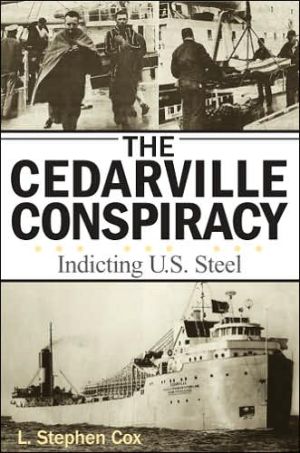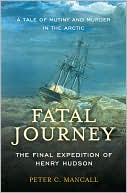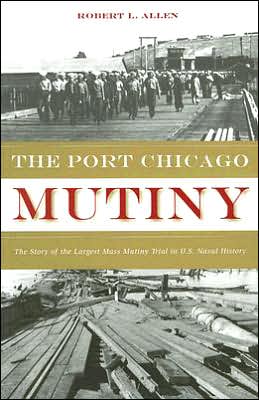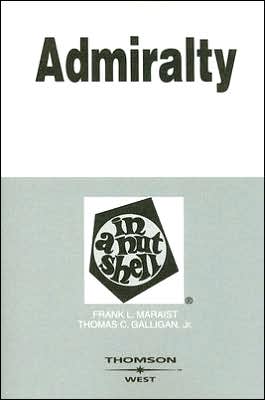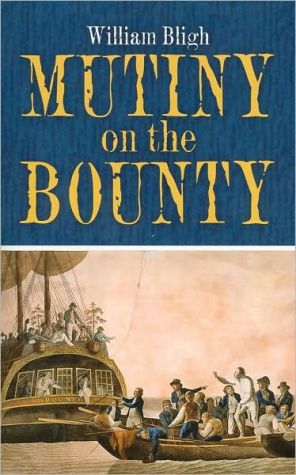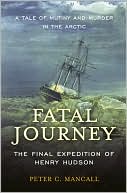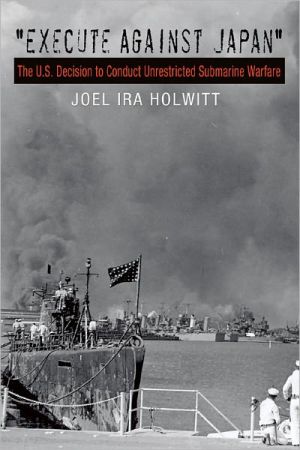The Cedarville Conspiracy: Indicting U.S. Steel
On the morning of May 7, 1965, the American freighter Cedarville collided with the Norwegian vessel Topdalsfjord in heavy fog in the Straits of Mackinac. Ultimately, ten crew members of the Cedarville died and a legal battle ensued implicating U.S. Steel—-the company that owned the Cedarville—-in the chain of events leading to the tragedy.\ The Cedarville Conspiracy is the story of that doomed ship and its crew. It is also the first Great Lakes history to expose the heroism, villainy,...
Search in google:
The first Great Lakes history to expose the heroism, villainy, courage, and confusion surrounding the tragedy of the freighter Cedarville
THE CEDARVILLE CONSPIRACY\ Indicting U.S. Steel \ \ \ By L. Stephen Cox \ THE UNIVERSITY OF MICHIGAN PRESS \ Copyright © 2005 \ L. Stephen Cox\ All right reserved.\ \ ISBN: 978-0-472-03063-7 \ \ \ \ \ Chapter One Return to Rogers City \ March 10, 1965 GRAND RAPIDS, MICHIGAN- 0638\ Accelerating through the sleepy early morning streets of Grand Rapids, the two-tone Ford LTD turned northeast onto Highway 131 to follow the Grand River for several miles before turning north again toward Cadillac. The six-hour drive would take a series of opposing turns as the car gradually worked its way diagonally across the mitt-shaped land mass that forms the Lower Peninsula of Michigan.\ "Slow down, Len. You're going to get a ticket."\ The speedometer needle hovered at sixty-two miles per hour. Avoiding the early morning glare, Leonard Gabrysiak-"Len" to his friends-glanced over at Pat and smiled, revealing a mild underbite. Pat was a small, attractive woman in her late twenties, glowing nicely from several months in Mexico. Gabrysiak, on the other hand, was exposed to the sun and wind year-round so never quite lost his tan.\ "You worry too much. Go back to sleep." He gave her a sideways wink and tapped the accelerator for good measure. The eight-cylinder engine revved as the car picked up more speed. Pressed back in her seat, Pat suppressed a smile, reclined against the locked door, and turned to watch the sunlight filter between the passing tree-lined hills as her eyes grew heavy once again. Lenny Jr., sleeping soundly in the backseat, barely stirred. Theirs was the only car on the road, and he wanted to make good time while he could.\ Gabrysiak was a tall, slender, square-jawed Michigan native of Polish descent with thoughtful eyes, a prominent nose, and a broad and easy smile. He and his family were bound for Rogers City on the northwest shore of Lake Huron for the start of the 1965 shipping season. They had migrated south when the lakes began to freeze the previous winter but were returning for the spring thaw.\ Thinking that he needed a cup of coffee, Gabrysiak squinted against the glare on his dusty, bug-spattered windshield as the road, veering eastward into a U-shaped valley, shifted the rising sun into full view. He flipped down his visor in response, feeling under the seat for the sunglasses he had purchased in Brownsville, Texas.\ The deeply forested hills and valleys through which the Gabrysiaks sped bore silent witness to the creeping flow of an ancient glacial force that had, over the millennia, repeatedly scoured the southern portion of the granitic Canadian Shield underlying present-day Michigan. Towering more than six thousand feet above the surrounding landscape, prehistoric rivers of ice and debris had once gouged the underlying strata to form and define the topography of much of modern North America.\ As the last ice age drew to a close eleven thousand years ago, the ice sheet that had covered the region's expansive basins of deeply carved bedrock melted, leaving behind a series of massive freshwater seas and tributary valleys. In one such valley, the two-lane road onto which Len had just turned wound slowly past the imposing vestiges of glacial rock and silt drumlins in its long descent to Lake Huron.\ * * *\ Gabrysiak was the last of six boys to take to the inland seas and was no stranger to the rigors of the profession. In fact, by the time he started sailing, one of his brothers had already been sacrificed to lake shipping. Len could recall the day, as a seventh-grader, he said goodbye to his brother Frances as he reported to Interlake Steamship Company on Lake Superior. The 602-foot bulk cargo carrier Edward Y. Townsend needed deckhands, and Frank filled the billet; but he would soon be lost overboard on a starless night within sight of the Minnesota shore.\ On June 27, 1945, the lanky twelve-year-old answered the door to find a uniformed Western Union courier waiting patiently on the front step. Signing the clipboard, Len thanked the courier and stepped back inside. The message was addressed to his father, but he opened it anyway.\ Len sprinted across First Street to find the elder Gabrysiak at the pub he co-owned in Rogers City with a curious fellow named Greka. Slamming the screen door, his heavy steps pounded on the wooden floor, disturbing a couple of off-duty Bradley Fleet seamen playing pool in the corner. Breathless, he spotted his father emerging from behind the counter and surrendered the opened telegram. This would ordinarily have earned him a scolding, but Marty Gabrysiak could see that something was wrong. Adjusting his glasses and finding a perch beside the bar, he read the message.\ June 26, 1945 Mr. Martin Gabrysiak Your Son Is Missing from E Y Townsend 5 Hours after Departure from Duluth. Was Going to Watch Station When Lost. Will Keep You Advised.\ Frank was never found. A search for his body was fruitless, as he was presumed to have drowned in the frigid waters. Although the family heard rumors that an investigation of his disappearance had taken place, they were never contacted by the Coast Guard, nor ever again by the Interlake Steamship Company. The outcome of the inquiry would remain a mystery.\ To his horror, Len later read that the extreme cold and lack of oxygen in the depths of Lake Superior would combine to preserve a human body indefinitely. The thought of his brother Frank drifting pale and wide-eyed along the cold, dark lake bottom would haunt him for the rest of his life. Nevertheless, he too chose to work offshore.\ * * *\ Still blinded by the glare, Len instinctively braked as he followed the curve of the road. Pat had fallen back to sleep, and his only company was the tinny voice of Patsy Cline warbling from the dashboard speakers. As "I Fall to Pieces" reached its crescendo, his mind turned back to the ship that he would call home for most of the season. He wondered how she had fared the winter. Floating empty where he had left her, Cedarville was probably home now to countless rats that had braved the frozen mooring lines for shelter from the northern Michigan winter. No telling what they had torn up this year. Pest control was a major fleet issue with the start of each new shipping season.\ * * *\ Len's employer, the Bradley Fleet, was a subsidiary of the United States Steel Corporation. Consisting of seven bulk ore carriers operating from Port Calcite, the fleet supplied limestone to the steel manufacturer from Rogers City quarries, where it was produced in abundance. Ore from the nearby mines was continuously crushed and loaded aboard the vessels, which in turn raced north, through the narrow Straits of Mackinac, then south through Lake Michigan to quickly unload in Gary, Indiana, and return. Although he had worked aboard several of the fleet vessels, Gabrysiak had been assigned to Cedarville for over a year.\ Originally christened the A.F. Harvey in 1927, the 604-foot bulk freighter was eventually converted to a self-unloader and renamed Cedarville in a ceremony hosted by her namesake on the Upper Peninsula. After thirty-eight years of service, she continued to be a key component in the chain of production supporting the American industrial machine. Even so, her busy schedule stalled each winter as ice sweeping in from Lake Michigan clogged the Straits, closing it to shipping traffic.\ * * *\ The previous shipping season had ended on December 17, as the vessels of the Bradley Fleet converged at Port Calcite for winter layup.\ Adjacent to the Presque Isle County limestone quarry, Port Calcite was a staging area for mountains of colorless limestone surrounding perpendicular shipping terminals, each barely wide enough to accommodate two vessels side by side. The entrance to the port was protected by an equally colorless gray-rock jetty projecting eastward into the sapphire blue waters of Lake Huron. The facility was just large enough to house six of the seven Bradley Fleet vessels for the winter.\ Churning the slushy waters of the port, the tugs Limestone and Dolomite were busy on that early winter day maneuvering the ungainly vessels into their restricted berths when Cedarville rounded the jetty. Third Mate Gabrysiak stood on the starboard bridge wing within earshot of the radio, his breath condensing in the chilling air, as he watched the Dolomite swing another self-unloader into position before gently guiding it into its berth at the south dock. Without bow-thrusters, the aging Bradley Fleet vessels were unable to turn in close quarters, so tug assistance was routinely needed to approach the pier. This day both tugs would be busy.\ A few feet away, the radio crackled to life. "Cedarville, this is Tug Limestone, approaching from the south. I will push you around for entry into the north terminal and then take a line." Gabrysiak glanced down at the deck crew assembled at the bow, preparing to cast an eight-inch manila hawser to the approaching tug. Cedarville would winter in the northern portion of the L-shaped terminal, its fantail almost touching the bow of the Calcite II, now doubling up lines in the western terminal. Gabrysiak heard the captain reply, "Roger, Limestone, standing by."\ Cedarville was the fourth U.S. Steel vessel to pull in for lay-up and would be the last to occupy a protected berth. In theory, all of the ships would undergo repairs and be ready for the new shipping season as soon as the spring ice conditions would permit.\ Earlier that morning, Gabrysiak had packed his belongings for the first time that season. He never took gear home when the ship pulled in for loading because he never knew when, at a moment's notice, she would be underway again. Elsewhere on the ship, most of the crew had also packed, and the hatches and deck gear were battened down for winter storage.\ Looking aft, Gabrysiak watched as Limestone emerged from behind the fantail and crossed Cedarville's wake at a hundred yards. Turning, the small tug parted the blue waters of the harbor into a white foam as it accelerated to catch up and come alongside the slowing larger vessel.\ Unlike most ships, the eighty-foot harbor tug was specifically designed to bump up against other vessels. Protected by rubber fenders and lengths of tattered fire hose, Limestone's bulbous bow was reinforced to withstand the stresses generated by its fifteen-hundred-horsepower engine against the sides of the bulk carriers that she tended. Even so, her bent mast and dented coaming spoke of a thousand previous encounters with the larger craft.\ Gabrysiak tracked the tug until it came in contact with his ship. Almost immediately he felt Cedarville swing to the right as she was maneuvered to enter the terminal. With the turn complete, Limestone disengaged and came forward. The Cedarville deck crew heaved a small line weighted with a heavy knot called a monkey fist. The line draped the tug's deck, with the monkey fist floating in the water on the far side. A tug crewman quickly took up the slack and pulled the smaller cord until an attached manilla line dangled from the ship towering overhead. Cedarville paid out the head line while another was secured aft, and Limestone was soon ready to guide Cedarville to the pier. Positioned so as not to be crushed between the massive ship and the pier, the tug guided Cedarville into her winter berth. Gabrysiak walked through the pilothouse to the opposing bridge wing as the ship closed on the wharf. He was joined by Captain Marty Joppich.\ From below the starboard bow, the tug gave a single blast of its whistle. "Ahead one-third," Joppich shouted into the pilothouse.\ Adjusting the engine order telegraph, Wheelsman Bill Asam answered, "Ahead one-third, aye. Engine room answers ahead one-third." He was anxious to go ashore. He and his girlfriend were planning to tie the knot during the break, and Patricia was probably waiting somewhere on the pier to spirit him away and finalize the wedding plans.\ "Very well," Joppich said.\ Behind Cedarville, limestone silt was churned up by her single four-bladed propeller as she maneuvered alongside the pier. "Left standard rudder. Steady up on three-five-five."\ Asam watched the compass swing as he called back, "Left standard rudder, aye. My course is three-five-five."\ Joppich allowed his ship to close with the pier for a few seconds before correcting her course once again. "All stop. Come right to zero-zero-four."\ Once again Asam answered, "Engine room answers all stop. My course is steady at zero-zero-four."\ Lifting his handheld radio, Joppich keyed the microphone. "Limestone, she's all yours."\ "Roger that, Cedarville. Bringing her in."\ As Cedarville's forward drift slowed, Limestone nudged the ship against the giant fenders lining the west dock. When she came to rest, Gabrysiak and Joppich watched as a flurry of mooring lines shot across the void to workmen waiting on the pier.\ With nothing to do for the moment, Len watched the exodus of seamen from the three ships already secured. Opposite Cedarville he saw Art Fuhrman jump from the gangway of the Calcite II. After waiting on the pier, Fuhrman's wife ran to meet him. Art had been assigned to the deck division of the Calcite II but was slated to transfer to Cedarville the following spring. The couple would likely celebrate the end of the season with a night on the town. In fact, most of the Bradley Fleet men would flock to local dives, but Gabrysiak was not sure about the other members of his watch team.\ Bill Asam was getting married. His bride-to-be doubtless had plans to keep him (and their five children) busy until well after the wedding.\ Stan Haske ... Well, Len didn't know what was wrong with him. The relief helmsman was in a foul temper for most of the last run. Now, leaning against the chart table aft of the pilothouse and holding his lower abdomen, he appeared to be in no mood for postseason revelry. Len had heard First Mate Piechan order Haske to see the company doc as soon as the ship was tied up. "I'll think about it" was the stalwart helmsman's curt reply.\ If the rumors about the captain were true, he would likely pass out at home with an open bottle once the ship was secured and turned over to the Bradley Fleet manager for winter repairs.\ As for Len, he, Pat, and Lenny Jr. would leave as soon as possible for Tampeco, Mexico, where they would winter for the fifth year in a row. They might even try to catch Mardi Gras in New Orleans on their return trip if the timing worked out. The lunar calculations employed to set the date for Easter and Ash Wednesday had always mystified Gabrysiak, and he could never be sure when Mardi Gras would actually fall. A personnel clerk had long ago told him that he couldn't draw unemployment benefits unless he filled out a work request for winter employment, but he was not interested. With his luck, they just might put him to work and his winter in Mexico would be shot. No thanks!\ * * *\ Now, as the Gabrysiaks continued their descent through the frequently marshy terrain of the Lower Peninsula, Len wondered how his captain and messmates had weathered the harsh Michigan winter. He would find out soon enough as the Cedarville crew reassembled to bring the ship out of winter hibernation.\ Reaching up, he touched the windshield with the back of his hand.\ Noticing the gesture, Pat asked, "Still cold out there?"\ "Yeah. So much for a warm spring."\ Chapter Two Headquarters\ March 15, 1965 PITTSBURGH, PENNSYLVANIA-\ Charles Khoury had taken a cab from the Duquesne Club, where he had enjoyed a nice, long breakfast. Founded in 1873, the Duquesne Club was renowned as the oldest and most prestigious of Pittsburgh's clubs, catering to the city's most influential businessmen. Steel chieftains frequented the plush dining and drawing rooms of the exclusive brownstone fortress, and Khoury reveled in the privilege. Tossing a few bills over the seat, he jumped from the taxi, crossed the street to 525 William Penn Place, and entered the towering Mellon Bank Building.\ Sweeping aside the heavy glass door, Khoury found the lobby nearly empty. Most U.S. Steel employees had been chained to their desks for more than an hour already, and the random click of leather on marble tile betrayed the presence of only a few well-dressed men, briefcases in hand, each hurriedly pointed for some unknown destination within the building.\ Khoury shared the elevator with a runner employed by a local courier service. Bound for the thirty-second floor, the courier carried a bundle of documents to be executed by one of the countless departments packing the overcrowded United States Steel headquarters building.\ (Continues...)\ \ \ \ \ Excerpted from THE CEDARVILLE CONSPIRACY by L. Stephen Cox\ Copyright © 2005 by L. Stephen Cox. Excerpted by permission.\ All rights reserved. No part of this excerpt may be reproduced or reprinted without permission in writing from the publisher.\ Excerpts are provided by Dial-A-Book Inc. solely for the personal use of visitors to this web site.\ \
Contents Preface....................xiPrologue....................1Map....................41. Return to Rogers City....................52. Headquarters....................133. Fit-Out....................194. Icebound....................305. Topdalsfjord....................406. Arrivals....................477. Passages....................608. Turnaround....................699. Fog....................7910. Approaches....................8911. Collision....................11012. Miscalculation....................11413. Capsize....................14314. Rescue....................14915. Damage Control....................17316. Limitations....................19517. Troublemaker....................20218. Intimidations....................20819. Closure....................222Epilogue....................227Author's Note....................229Bibliography....................239Index....................245
